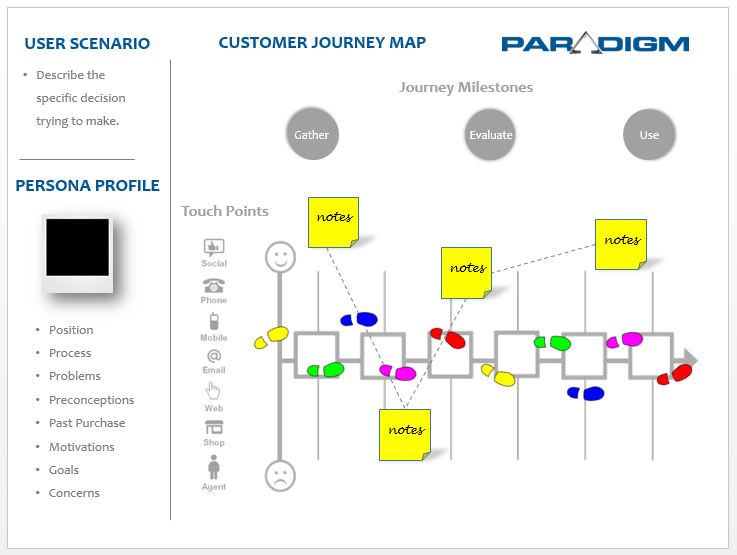How to Walk the Walk and Talk the Talk with Prospective Customers
Most companies describe themselves as “customer-centric”, but when you look at their web design and other marketing touchpoints, you wonder if they really meant what they said or if they just define the concept differently.
For an outside-in view of your company, use journey maps to experience what it’s like for customers at each juncture of their decision-making process. Customer journey maps are one of many tools used to help build empathy and a customer-centric perspective.
Mapping Your Prospective Customers’ Journey
The power of journey maps is in their ability to simply and effectively communicate what potential customers think and feel as they work toward achieving their goals. It is an excellent tool for identifying and appreciating customer pain points, identifying improvement opportunities, gaps between expectations and perceptions, and sharing a common vision with your marketing partners and across your organization.
As an example, a journey map could help everyone on the team think proactively about different scenarios a visitor may encounter when designing and developing a website so positive experiences could be enhanced and potential obstacles removed.
It takes three simple steps to begin walking in your customer’s shoes.
- Gathering research on your customers and their experience.
- Illustrating your findings.
- Refining is based on feedback from your customers and others in the organization.
While there is no one right way to create a journey map, there are commonalities found in most customer-centric efforts.
- GATHER RESEARCH. Start with a persona profile. Persona profiles help you look through the eyes of a single customer that most effectively represents a broader segment’s unique wants, needs, and objectives. Your goal is to immerse yourself in their lives to understand their world, fairly intimately, and how your website could be most helpful to them. Start by clearly identifying your customer and include what’s most important to them – bringing the data you unearth (and your customer) “to life”.Analyze the category they represent in the industry, trends relating to them and their position, and speak with people from sales and other parts of your company who interact with your market. This approach will help you gain an empathetic understanding of what users are trying to accomplish so you could help define the best path to get them there.
- ILLUSTRATE YOUR FINDINGS. Chart out major milestones throughout your customer’s journey with your brand. Despite the depth and breadth of the research conducted and data gathered, resist the urge to include everything you’ve learned. Think of it as the most important aspects of your research representing a visual summary of your findings. Keep your journey map simple so people at any level of familiarity with the situation could understand it easily.
- REFINE YOUR JOURNEY MAP WITH FEEDBACK. Bring together a cross-functional, customer-facing group and share it with them and the customers used to develop your persona profiles. Doing so will help you spot key interactions and non-obvious relationships between elements you might have otherwise overlooked.
Even though journey maps can’t account for every user, in every situation, they do give people working on your website and your company reason to pause, put their biases and assumptions aside, and think about scenarios with your customer’s eyes. While this customer-centric approach to design and development can take time, it also differentiates empathetic companies who align with their markets from those who don’t.

